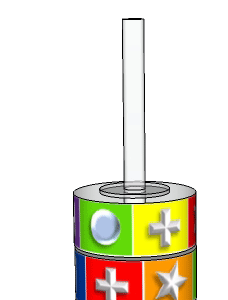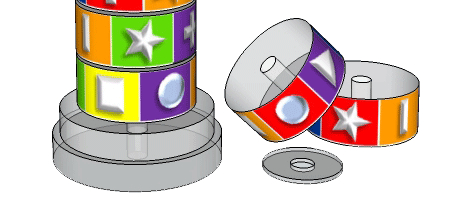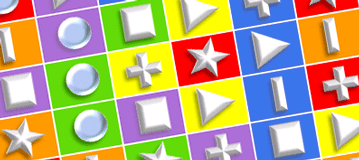Q1. Why can't I do this stupid puzzle?
Q2. Do you make easier / harder versions?
Q3. I can't cheat the online Tubie, but I can on the real thing. Why is this possible and is it permissible?
Q4. Why is the position where all the red pins are lined up called En-Ra-Ha?
Q5. How can you have an archive? You're supposed to be something new.
Q6. Why do some of your solutions not work?
Q7. Isn't the Tubie just another unnecessary plastic object?

Q1. Why can't I do this stupid puzzle?
You can! You may just be in a bad place at the moment. Push the red pins together and have another go. Best advice is to try to line up the wheels with the fewest pins first, that seems to help. And you have to expect to undo some progress as you work to get further.
If you want to learn the really neat and impressive way to do it, follow the method on the Sudoku page, which is not hard, or the general method on the Solutions page. Better still, look for your puzzle on the Play page and click the Solutions buttons there. But you may as well enjoy going round the houses like the rest of us. The satisfaction will be all the greater when you arrive.

Q2. Do you make easier / harder versions?
The Tubie comes with five rotating wheels (and one stationary reference wheel), and with 12 pins in the pattern 3,3,2,2,2. This gives a puzzle that is harder than it looks, but not absurdly so. We want you to keep playing it, not discard it and go back to work.
A puzzle with fewer pins would be easier to solve, as you have more freedom of movement, and one with more pins would be harder to solve as the wheels interfere with one another. You can test out how different pin patterns alter the complexity of the puzzle on the Playscreens. More wheels in particular add to the difficulty. Future versions may well include harder and easier alternatives.


Q3. I can't cheat the online Tubie, but I can on the real thing. Why is this possible and is it permissible?
Well, you would work hard to shake the wheels out of position, but it is possible to fiddle around so as to get in between the pins. This is called a Sneaky Half-move. It would not be approved for competition play, and would not be impressive in a demonstration. Lesser mortals might do it, but hold your head up and say you solved the Tubie without cheating!

Q4. Why is the position where all the red pins are lined up called En-Ra-Ha?
Because "the position where all the red pins are lined up" is a bit of a mouthful. When the puzzle was evolving, I kept having to go back to the start to see what would work, and found myself muttering "Back to the position where...". En-Ra-Ha arose as the shorthand term of choice because I had just seen Mike Leigh's excellent film Happy-Go-Lucky where the word plays an important role, as you can see here.

Q5. How can you have an archive? You're supposed to be something new.
Because we didn't want to lose sight of all the hand-made designs that used to be available, before we became the global brand you see now. And some of the designs have little games in them too.

Q6. Why do some of your solutions not work?
They do all work, but it's quite easy to make a wrong move. First make sure that your red pins are in the right place. Then check that only the listed pins are being moved, and remember that the first wheel (wheel 0) cannot be moved so wheel 1 is the second wheel in. Also check that you're going in the right direction, Up or Down. If it comes out wrong, just go back to En-Ra-Ha and have another go.

Q7. Isn't the Tubie just another unnecessary plastic object?
It is certainly plastic, several parts being made from solid acrylic. The first prototypes were made in wood but we moved to plastic to make it easier to see through. There is an environmental and social impacts from the oil, but you will have the Tubie for ever, so it's not so bad. Is it unnecessary? Well, clearly, but it's fun.
